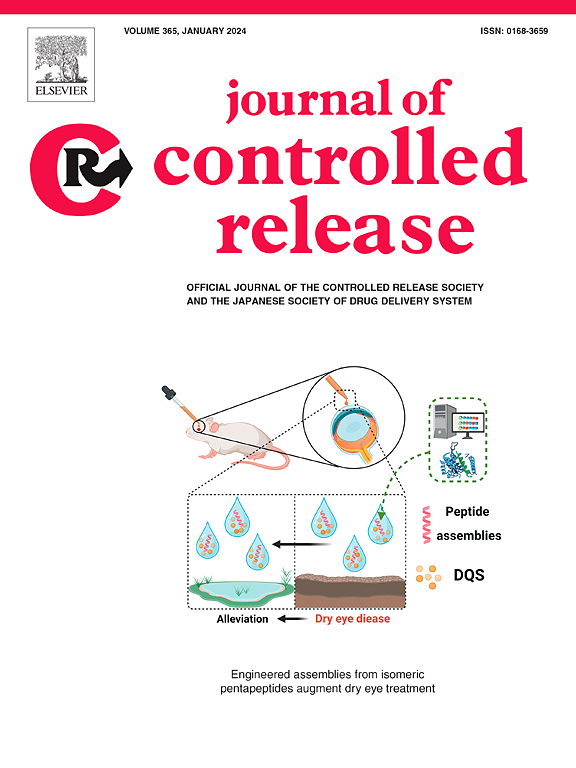Bone-targeting ZIF-8 based nanoparticles loaded with vancomycin for the treatment of MRSA-induced periprosthetic joint infection
IF 10.5
1区 医学
Q1 CHEMISTRY, MULTIDISCIPLINARY
引用次数: 0
Abstract
Periprosthetic joint infection (PJI) caused by methicillin-resistant Staphylococcus aureus (MRSA) has become a global healthcare burden owing to increased drug resistance. The effectiveness of traditional antimicrobial drugs in their treatments is becoming increasingly limited. The search for new drug delivery strategies may help to address this issue. In this study, we fabricated vancomycin (Van)-loaded and zoledronic acid (ZOL)-modified zeolitic imidazolate framework-8 (ZIF-8) nanoparticles (NPs), named VZZ-8 NPs, which could effectively treat MRSA-induced PJI. ZOL endowed VZZ-8 NPs with preferential bone-targeting capability, particularly accumulating at sites of elevated bone metabolism during injury/infection, thereby ensuring maximized therapeutic bioavailability in vivo. VZZ-8 NPs maintained ZIF-8-mimetic stability at physiological pH (7.4) yet rapidly degraded in acidic infection microenvironments (pH 5.0), enabling on-demand co-release of Zn2+ and Van for synergistic antibacterial effects. Moreover, Zn2+ released from VZZ-8 NPs disrupted bacterial membrane permeability, thereby potentiating Van antimicrobial activity and reducing the required therapeutic dosage of Van. In vitro studies demonstrated that VZZ-8 NPs effectively eradicated 93.84 ± 7.38 % of MRSA and inhibited biofilm formation by 95.36 ± 0.13 %. In a murine model of MRSA-induced PJI, VZZ-8 NPs displayed robust antibacterial efficacy while simultaneously suppressing local TNF-α and IL-6 expression and preventing infection-mediated osteolysis, demonstrating comprehensive therapeutic potential for PJI treatment. Consequently, the engineered VZZ-8 NPs developed in this study provide an effective therapeutic approach for MRSA-induced PJI through their dual capability of targeted delivery and pH-responsive drug release.


负载万古霉素的骨靶向ZIF-8纳米颗粒用于治疗mrsa诱导的假体周围关节感染
耐甲氧西林金黄色葡萄球菌(MRSA)引起的假体周围关节感染(PJI)由于耐药性的增加已成为全球卫生保健负担。传统抗菌药物的治疗效果越来越有限。寻找新的给药策略可能有助于解决这一问题。在本研究中,我们制备了万古霉素(Van)负载和唑来膦酸(ZOL)修饰的沸石咪唑酸框架-8 (ZIF-8)纳米颗粒(NPs),命名为VZZ-8 NPs,可以有效治疗mrsa诱导的PJI。ZOL赋予VZZ-8 NPs优先的骨靶向能力,特别是在损伤/感染期间骨代谢升高的部位积累,从而确保最大限度的体内治疗生物利用度。VZZ-8 NPs在生理pH(7.4)下保持zif -8模拟的稳定性,但在酸性感染微环境(pH 5.0)下迅速降解,从而实现Zn2+和Van的按需共释放,协同抗菌作用。此外,VZZ-8 NPs释放的Zn2+破坏了细菌膜的通透性,从而增强了Van的抗菌活性,减少了Van所需的治疗剂量。体外研究表明,VZZ-8 NPs有效根除93.84 ± 7.38 %的MRSA,抑制95.36 ± 0.13 %的生物膜形成。在mrsa诱导的PJI小鼠模型中,VZZ-8 NPs显示出强大的抗菌作用,同时抑制局部TNF-α和IL-6表达,防止感染介导的骨溶解,显示出PJI治疗的综合治疗潜力。因此,本研究开发的工程化VZZ-8 NPs通过其靶向递送和ph反应性药物释放的双重能力,为mrsa诱导的PJI提供了有效的治疗方法。
本文章由计算机程序翻译,如有差异,请以英文原文为准。
求助全文
约1分钟内获得全文
求助全文
来源期刊

Journal of Controlled Release
医学-化学综合
CiteScore
18.50
自引率
5.60%
发文量
700
审稿时长
39 days
期刊介绍:
The Journal of Controlled Release (JCR) proudly serves as the Official Journal of the Controlled Release Society and the Japan Society of Drug Delivery System.
Dedicated to the broad field of delivery science and technology, JCR publishes high-quality research articles covering drug delivery systems and all facets of formulations. This includes the physicochemical and biological properties of drugs, design and characterization of dosage forms, release mechanisms, in vivo testing, and formulation research and development across pharmaceutical, diagnostic, agricultural, environmental, cosmetic, and food industries.
Priority is given to manuscripts that contribute to the fundamental understanding of principles or demonstrate the advantages of novel technologies in terms of safety and efficacy over current clinical standards. JCR strives to be a leading platform for advancements in delivery science and technology.
 求助内容:
求助内容: 应助结果提醒方式:
应助结果提醒方式:


